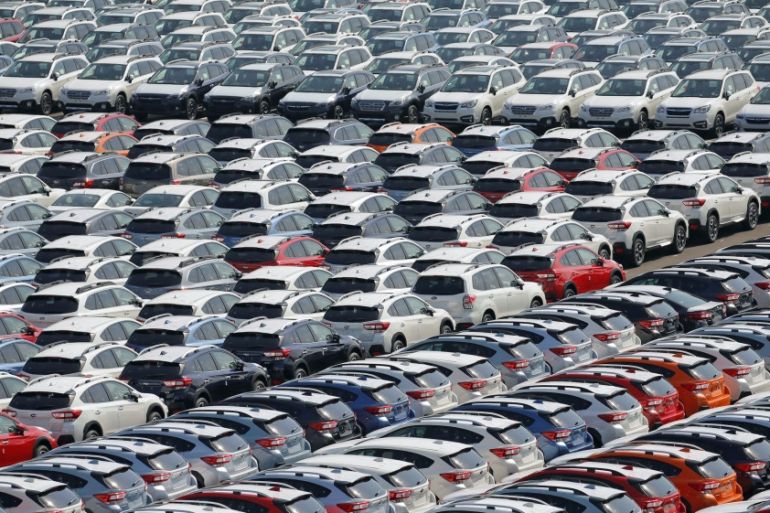Japan’s recession is likely to deepen, latest grim data shows
Factory output, retail sales, unemployment all worsened, as government rolls out significant stimulus programme.

Japan’s factory output slid faster than expected and retail sales tumbled the most in more than 20 years in April, as the coronavirus pandemic wrecked both foreign and domestic demand for the country’s cars and other manufactured goods.
The bad numbers suggest the recession seen in the world’s third-largest economy over the six months to March is likely to deepen in the current quarter as government-imposed lockdowns disrupted supply chains and kept consumers shut in at home.
Keep reading
list of 3 itemsJapan plans to top up trillion-dollar stimulus to help economy
UK to start trade talks with Japan, with US and EU talks ongoing
Official data on Friday showed factory output slipped 9.1 percent in April from the previous month, the biggest drop since comparable data became available in 2013 as automakers and iron and steel manufacturers suffered sharp declines.
That was a much larger decline than the 5.1 percent drop in a Reuters News Agency forecast.
“Output will probably pick up from June onwards but it will be necessary to remain on guard for a second wave (of coronavirus infections),” said Takeshi Minami, chief economist at Norinchukin Research Institute.
“The pace of a rebound will likely continue to be sluggish.”
Automaker production fell by a third from the previous month. That led the government to downgrade its description of overall production to “decreasing rapidly” for the first time since November 2008, from just “decreasing” previously.
Nissan Motor Co plans to slash production capacity and model range by about a fifth to help cut costs by 300 billion yen ($2.79bn) following a slide in sales, the automaker said on Thursday.
Separate data showed retail sales tumbled at their fastest pace since March 1998 as the nationwide state of emergency led service-sector businesses such as restaurants to close.
Retail sales plunged 13.7 percent in April from a year earlier, heavily weighed by slumping demand for general merchandise, clothing and vehicles.
The gloomy data comes after Japan’s economy fell into recession for the first time in four and a half years in the first quarter.
The government this week lifted the state of emergency and approved a second $1.1 trillion stimulus package, bringing the total pledged to save the economy from the pandemic to $2.2 trillion.
Joblessness up
Japan was already trying to shake off weak demand before the outbreak after the government raised the nationwide sales tax to repair its public debt burden.
The largest component of the government’s new stimulus package was a loans programme for smaller firms in immediate need of cash to keep the lights on.
Other government data on Friday showed worsening conditions in the jobs market, suggesting such support for small- and medium-sized firms remained much-needed to prevent further losses.
The April jobless rate rose to 2.6 percent its highest since 2017, although much lower than the rates in other developed nations, where unemployment is approaching depression-era levels.
However, economists say the official unemployment rate masks the full extent of the pain. Among those categorised as employed, those in furlough more than tripled to 4.2 million in April from March.
While many furloughed staff will eventually return to work, their inclusion in April’s unemployment figures would suggest a rate of 11.4 percent, Dai-ichi Life Research Institute said.
The number of non-regular workers posted the biggest year-on-year drop on record. Job availability slipped to 1.32, its lowest since March 2016.
Analysts said jobs pain is mostly concentrated in the service sector as opposed to automakers, which were hit badly during the 2009 global financial crisis.
“If demand around cars doesn’t recover, there’s a possibility employment conditions in the manufacturing sector will worsen more going forward,” Minami said.
The factory output data showed manufacturers surveyed by the government expect output to fall another 4.1 percent in May, followed by a 3.9 percent rise in June.
“The huge fall in industrial production and retail sales in April support our below-consensus forecast that the economy will contract by 12 percent quarter on quarter this quarter. The unemployment rate is also set to approach the 4 percent we have pencilled in,” said Tom Learmouth, Japan Economist at research firm Capital Economics, in a note sent to Al Jazeera.
“But with the spread of the virus now under control, the economy should bounce back in the second half of the year,” Learmouth added.
With the state of emergency having been lifted nationwide on Monday, the question now shifts to how quickly businesses can resume activity. Economists see the economy shrinking more than 20 percent this quarter, the most in records going back to 1955 and say a rebound could be slow as exports, tourism and business investment struggle to rebound.
“A V-shaped recovery is impossible,” said economist Harumi Taguchi at IHS Markit. “As the impact of the coronavirus lingers, jobs and incomes will suffer a lot. This is a dire situation. If production continues to be scaled back, we may see job losses in manufacturing, too.”
Japan’s Prime Minister Shinzo Abe’s approval ratings have fallen, so continued weakness in the economy is likely to keep pressure on him to add more stimulus. Some analysts expect a third or even a fourth extra budget will be needed this year.
Bank of Japan Governor Haruhiko Kuroda has pledged to do whatever is needed to support the economy, but Friday’s data are unlikely to raise the odds of additional easing anytime soon because the results were broadly in line with expectations.